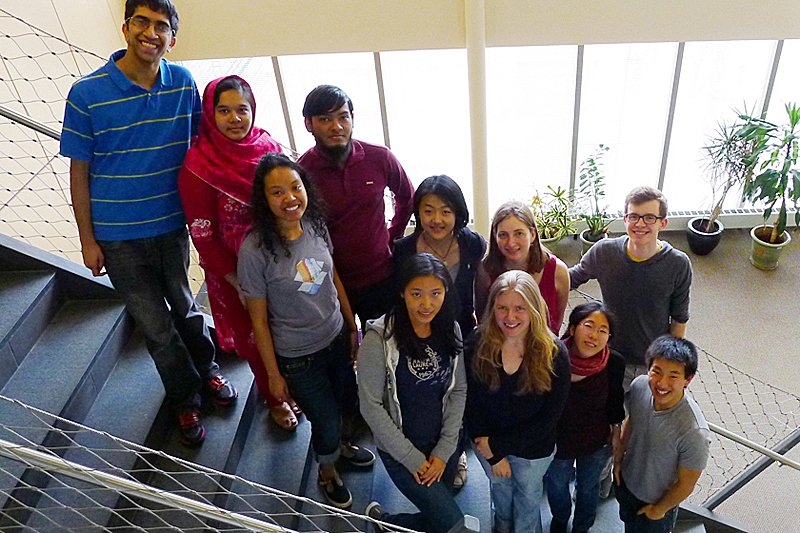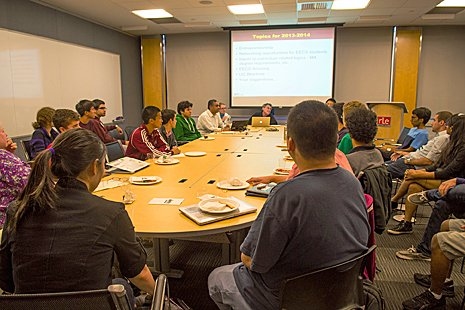When Anantha Chandrakasan, the Joseph F. and Nancy P. Keithley Professor of Electrical Engineering, took the helm of MIT’s Department of Electrical Engineering and Computer Science (EECS) in 2011, he quickly set two big ideas into motion. One was to make the Undergraduate Research Opportunities Program (UROP) more appealing to EECS majors. The goal was to offer Course 6 undergraduates more research options within the department, as well as chances to work on longer-term, sustained projects.
The other was to form the Undergraduate Student Advisory Group in EECS (USAGE) to help him understand the student perspective. This group provided pivotal feedback that helped guide decisions about UROPs. Giving the students a stronger voice has transformed the department into more than a place where students come to learn about devices, signals, theory and systems: Course 6 is also a place where students become leaders.
Group dynamics
Aside from coursework, one of the ways students engage with the department is through student groups. The new USAGE group joined established groups that include Eta Kappa Nu, the EECS National Honor Society; ACM/IEEE, a nationwide organization; EECS Refs, a group of graduate peer mediators; the Graduate Student Association (GSA); and GW6, the graduate women students’ association.
Typically these groups enhance the department environment by organizing social activities and providing peer mentoring and support. These groups also provide key perspective on new departmental initiatives to advance and strengthen the department.
To bring a student perspective to the selection of new faculty members, Chandrakasan and the two associate department heads, William T. Freeman and Munther A. Dahleh, set up a new group composed of undergraduate and graduate students to evaluate faculty candidates. While students had met with faculty candidates in the past, the department had never before formally requested student input in such decisions.
In this role, the students met as a group with the individual candidates and provided integrated written feedback based on their impressions. “I liked the idea of giving student input,” says Victor Pontis, a junior. “There are so many great candidates, why not choose the ones able to connect with students?”
The experience also gave students a glimpse into what they might someday go through, should they choose an academic career. “I got to see an insider’s view of how the hiring process works,” says Phillip Nadeau, a fifth-year doctoral student. “I think we brought a different perspective that was valuable to the faculty in their deliberations.”
“Student input was a useful addition to the many dimensions we consider in faculty hiring,” Chandrakasan says. “I was really delighted that they took this job very seriously.”
EE and CS network
Given the resonant theme of leadership in the department, student groups have begun to act on the department’s initiatives on their own. Several groups in EECS already have two of the department’s top priorities for the current academic year — entrepreneurship and building community — on their radar.
For instance, the GSA recognized that having more than 700 graduate students distributed across 120 faculty groups in the largest department at MIT made interaction difficult. In addition, student and faculty interests vary widely, from solar cells to mobile apps, and from circuitry to cryptography. With CS students working in one building and EE students in others, “students don’t mingle much,” says Rachael Harding, co-president of the GSA.
So she, co-president Joel Jean, and the rest of the group took action. They started up the GEECS (pronounced “geeks”) Coffee Hour on the 8th floor of Building 36, with a great view of the city. They also started a research support network, in which a dozen or so students get together each month to hear students present their research informally over dinner. “I’ve been learning about solar cells and signal processing,” says Harding, a member of the Computer Science and Artificial Intelligence Lab (CSAIL).
Students get feedback on their presentations — valuable input for burgeoning academics. In one instance, a student learned that needed equipment was available in another EECS lab. Over pizza, a collaboration between student researchers was born. “It was really exciting to see that kind of an exchange in an informal venue,” Harding says.
By organizing and participating in departmental activities — such as running student and laboratory conferences, mentoring undergraduate researchers, and tutoring and counseling fellow students — EECS graduate students are taking important steps toward becoming professionals themselves. “That’s also leadership,” Chandrakasan says. “We’d like to give our students as much opportunity as possible to participate in shaping their futures and the future of the department.”
Worldviews
Back in 2011, when Chandrakasan began to design the new UROP program, he started by talking with the faculty. “We thought about it a lot and came up with a program focused on giving our students a way to generate publication-worthy research,” Chandrakasan says. “We were all excited.”
But when he ran the idea by students at one of his first USAGE advisory meetings, it was clear he needed to adjust the proposal.
Catherine Olsson ’12, MEng ’13 represented one view. She had bypassed summer UROPs even though she was interested in a research career because internships offered pay and prestige that was just too hard to pass up. “We needed to make these research opportunities more glamorous and financially attractive,” explains Olsson, who is now a doctoral student in computational neuroscience at New York University.
Denzil Sikka ’13, who is currently enrolled in MIT’s MEng program, represented another view: “It’s hard to fit UROPs into the Course 6 workload, especially since grades are so important for students interested in going into industry.”
The students didn’t all agree with one another during USAGE meetings, but because the conversations were open and focused on positive change, they gravitated away from tension and toward solution. “Ideas just bubbled out of these very organic conversations we were having,” Olsson says. “It was a really productive back-and-forth.”
Chandrakasan contributed a big part to that dynamic. “It felt like we were being heard and that he was giving a lot of consideration to what we were saying,” Sikka says.
Indeed, he was: The department added prestige by funding selected Research and Innovation Scholars, and offered both research and industry-focused projects. The EECS SuperUROP program is now considered an enormous success, with participation in both short- and long-term projects up substantially and continuing to grow. Several projects in the first year of operation have gone on to become the seeds of new ventures and new research agendas.
Perhaps more importantly, the program might never have gotten off the ground if students had not been given a voice. According to the students, the leaders in the department have given generously of their time, attention and consideration.
This, Chandrakasan says, is the point: “We look to students to come up with things that we don’t see. That’s the power of student input.”
Publication Date:

Caption:
The current GSA leadership includes (back row, from left): G. Kamath, Saima Afroz Siddiqui, Ahmad Zubair, Xiaowei Cai, Rachael Harding, Julian Straub. (Front row, from left): Leilani Battle, Jenny Lee, Samantha Dale Strasser, Reyu Sakakibara, Joel Jean.
Credits:
Photo: Austin Collins

Caption:
The 2013-14 members of the Undergraduate Students Advisory Group in EECS meet to discuss the upcoming year and the topics they will consider with EECS Department Head Anantha Chandrakasan, EECS Undergraduate Officer Albert Meyer and Undergraduate Administrator Anne Hunter.
Credits:
Photo: Patricia Sampson/EECS

Caption:
HKN Leaders gather at the Media Lab. Back row (from left): Benoit Landry, co-webmaster; Rishabh Kabra, Underground Guide editor; Cody Coleman, president; and Dawit Zewdie, vice president. Front row (from left): Helen Li, co-webmaster; Erika Ye, resume book chair; Yin Fu Chen, women's outreach; and Stephanie Chang, corresponding secretary and Eligibles chair.
Credits:
Photo: Patricia Sampson/EECS

Caption:
GW6 (Graduate Women in EECS-Course 6) current co-presidents are (from left) Gauri Joshi, Bonnie Lam and Qing He.
Credits:
Photo courtesy of GW6





